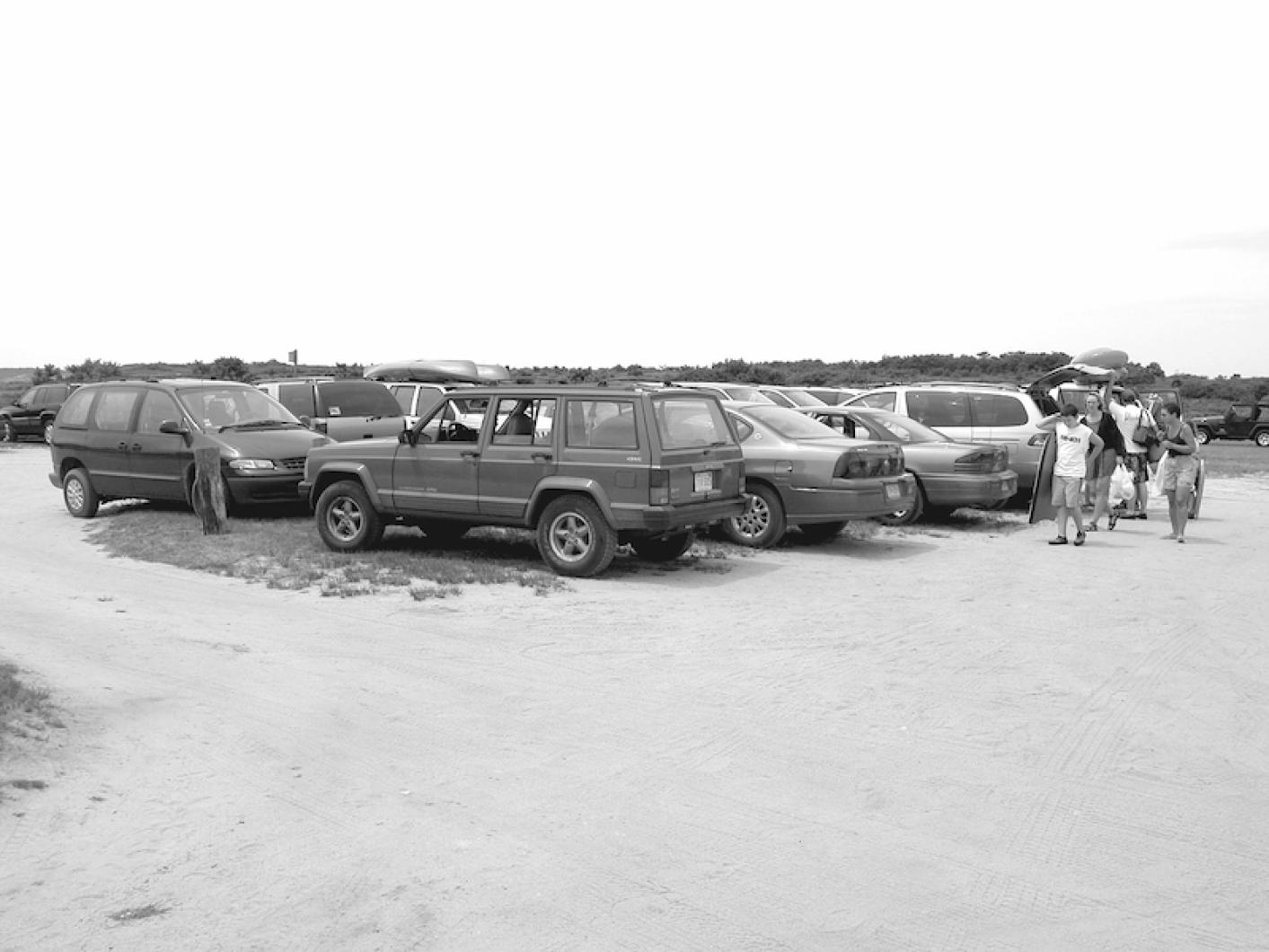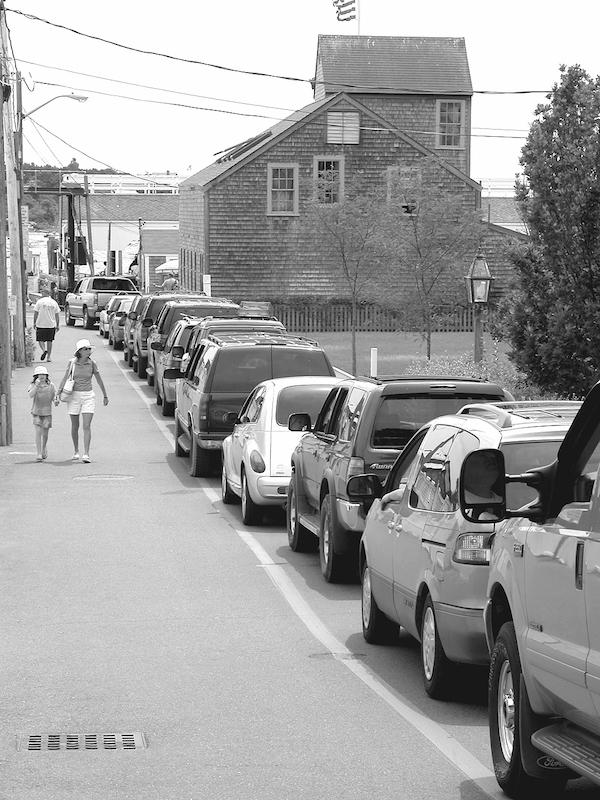Unspoiled beaches. A quiet, rural island community. Canoes and kayaks for rent. Cool caps and T-shirts for sale. Hundreds of cars. Long ferry lines. Fresh talk about how to manage it all.
This is the latest sketch from Chappaquiddick, where discussion has begun to heat up around a new long-range plan for two key properties owned by The Trustees of Reservations: Cape Pogue Wildlife Refuge and Wasque Reservation.
Cape Pogue and Wasque include more than 700 acres of pristine barrier beach that runs from the extreme southeastern tip to the extreme northeastern corner of Chappaquiddick.
Released this spring, the draft management plan is marked by an array of recommendations, including expanded education programs, year-round bathroom facilities and limits on nighttime access to the beach except for fishing. The plan also includes a summary of traffic statistics collected last year by the Trustees. The report claims that summer car traffic bound for Cape Pogue and Wasque accounts for about 25 per cent of the daily traffic on the Chappaquiddick ferry.
But recently the traffic numbers got a new look.
Using the Trustees' own numbers together with a separate Chappy traffic study done by the Martha's Vineyard Commission last year, Lionel Spiro, the president of the Chappaquiddick Island Association (CIA), found that in fact the Trustees are responsible for more than 50 per cent of the car traffic during peak periods on the Chappy ferry.
Chris Kennedy, who is Regional Islands Superintendent for the Trustees, admitted this week that the traffic numbers in the draft management plan may be misleading.
"Traffic surveys are great, but they do not necessarily give you the full picture," Mr. Kennedy said, adding:
"Clearly we're a significant portion of the ferry line, and if you take a step back it is correct to say that the Trustees are clearly responsible for a majority of the traffic that comes over on the ferry during the peak hours."
Leaders at the CIA and the Trustees are now squaring off over the management plan.
"The present draft of the management plan . . . does not clearly acknowledge that the organization is seriously impacting the daily lives of Chappy residents and taxpayers," declared Mr. Spiro in a statement that is published on the commentary page of today's Gazette.
Mr. Spiro, who also serves on the local committee for the Trustees, framed his statement around clear words of support for the Trustees. "Many of us have admired and given financial support to the Trustees. Residents of Chappaquiddick donated most of the Chappy land that the Trustees now own," he wrote.
Mr. Spiro has compiled an array of facts that show a startlingly high level of quasi-commercial activity on Chappy properties owned by the Trustees. Among other things, he found:
* The Trustees own 94 properties statewide that encompass some 23,000 acres. Cape Pogue, Wasque and the Leland Beach (owned by the state but managed by the Trustees) include about 838 acres, or less than four per cent of the total Trustees holdings.
* Statewide, the Trustees will offer 1,577 tours and events in June, July and August this year; 828 of these tours and events are on Chappaquiddick.
"To put it another way, Chappy properties, four per cent of TTOR's total, are burdened with 52 per cent of its events," Mr. Spiro wrote in a recent letter sent out to CIA members.
The draft management plan is slated for discussion at the August meeting of the CIA tomorrow morning at the Chappaquiddick Community Center. The Trustees are also set to host two public meetings on the plan on August 14 and again on August 16.
Among other things, Mr. Spiro is now urging the Trustees to eliminate advertising and promotion for their Chappaquiddick programs, which include a wide array of tours for visitors, plus what he called "a robust trade" in canoe and kayak rentals. A stand set up on the Dike Road for the sale of T-shirts and other merchandise is added cause for friction.
"No one is suggesting that limitations should be placed on visitors who wish to visit Trustees properties. But because of limited ferry access, Chappy residents would appreciate the elimination of the advertising and promotion to attract a constant flow of visitors," Mr. Spiro wrote.
Mr. Kennedy admitted that much has changed since the last management plan was done 13 years ago. "In 1989 our plan talked about the need for increased education and interpretation. But it didn't talk about T-shirts and baseball caps," he said.
"It is time to update this plan and take a fresh look. And we know that there is a fine line between education and interpretation and promotion," he added.
Mr. Kennedy said in recent years the Trustees have consciously cut back on advertising. He said radio advertising has been eliminated and the Trustees now place small advertisements in local newspapers and on area passenger ferries to promote the Chappaquiddick programs.
"We only do passive advertising," Mr. Kennedy said. "And we're taking a look at those ads right now and saying do they make sense," he added.
The management plan envisions a new education center on Chappaquiddick in the future, and this has sparked concern about added development.
Mr. Kennedy said it was just an idea.
"We just didn't do a very good job of explaining in the plan what we were talking about. Many people saw it as a fait accompli - but that's not what is going on here," Mr. Kennedy said.
A final management plan was due out in July, and recently the date was moved to September, but Mr. Kennedy said at this juncture there is no clear date for a final plan.
"We are going to get more feedback before we decide what to do," he said, adding: "Any final plan isn't going to be written in a dark closet someplace."
The plan details the source of revenues from Cape Pogue and Wasque, including over-sand vehicle permits (25 per cent), tours (21 per cent), merchandise (8 per cent), membership (28 per cent) and admission fees (10 per cent). Expenses are broken down as follows: personnel (40 per cent), administration (22 per cent), tours (13 per cent), property operations (25 per cent).
The Trustees report that the Chappaquiddick properties break even, but actual numbers and financial statements are not made public. "Our policy has always been to not release our operating numbers," Mr. Kennedy said.
But it is known that the income from Chappaquiddick is some six times higher today than it was in 1989.
Between 1989 and 1997, property income on Chappaquiddick went from $199,538 to $324,960. In 1997 the Trustees stopped issuing regular reports about property income, but two years ago income was reported verbally at about $600,000.
The annual report for the Trustees last year showed total revenues of $7.7 million, not including endowment income. At $600,000, the income from Chappaquiddick comes to about eight per cent of the total nonendowment income for the Trustees. With Chappy land holdings at only four per cent of the total, "It's obvious that the Chappy properties are being used to generate a disproportionate amount of the organization's total revenue," Mr. Spiro said.
"I don't think that there's any disagreement on the major points here at all - there needs to be a lot more discussion. It affects us, and it affects people who live on Chappy," said Mr. Kennedy. "This has been a useful dialogue," he added.
Concluded Mr. Spiro: "A mission to preserve land and open properties to the public can have conflicts - and when there's a three-car ferry, that compounds it."







Comments
Comment policy »